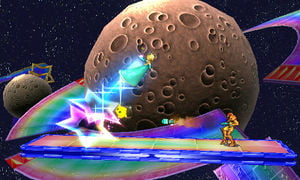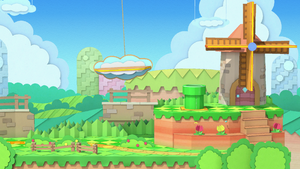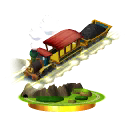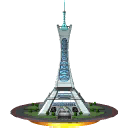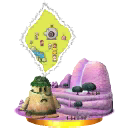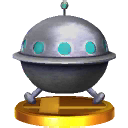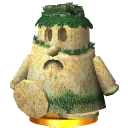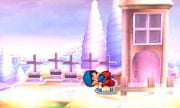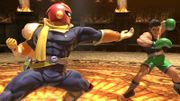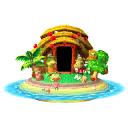List of stages debuting in Super Smash Bros. for Nintendo 3DS
This is a list of Super Smash Bros. series stages that debuted in Super Smash Bros. for Nintendo 3DS. The page details their role in this series.
See also:
- List of stages debuting in Super Smash Bros.
- List of stages debuting in Super Smash Bros. Melee
- List of stages debuting in Super Smash Bros. Brawl
- List of stages debuting in Super Smash Bros. for Nintendo 3DS and Super Smash Bros. for Wii U
- List of stages debuting in Super Smash Bros. Ultimate
3D Land[edit]
- Main article: 3D Land
In Super Smash Bros. for Nintendo 3DS and Super Smash Bros. Ultimate, 3D Land is available from the start.
Golden Plains[edit]
- Main article: Golden Plains
In Super Smash Bros. for Nintendo 3DS and Super Smash Bros. Ultimate, 3D Land is available from the start.
Rainbow Road[edit]
- Main article: Rainbow Road (stage)
Rainbow Road only appears in Super Smash Bros. for Nintendo 3DS as a stage available from the start.
Paper Mario[edit]
- Main article: Paper Mario (stage)
In Super Smash Bros. for Nintendo 3DS and Super Smash Bros. Ultimate, Paper Mario is available from the start.
Gerudo Valley[edit]
Gerudo Valley is a stage appearing in Super Smash Bros. for Nintendo 3DS and Super Smash Bros. Ultimate. It is based on the location of the same name in The Legend of Zelda: Ocarina of Time, but the graphical style is specifically based on The Legend of Zelda: Ocarina of Time 3D.
The stage is set in the valley itself, on the bridge dividing the Gerudo Fortress from Hyrule Field. Two platforms appear on the land on both sides of the chasm. The bridge can be destroyed with enough attacks, causing fighters on it to fall down the chasm; beneath the bridge is a pair of platforms on both sides of land, and underneath those platforms are spikes. After a while, the Song of Time plays, and the bridge repairs itself.
Koume and Kotake will appear whenever the bridge is broken, and one of them will cast a spell that changes the environment on one side of the stage. Kotake casts an ice spell that covers the right side of the stage in spikes of ice, freezing any players on contact, while Koume casts a fire spell that covers the left side of the stage in flames that deal damage and knockback.
The Final Destination version of the stage is set on a platform with the valley in the background.
The unlock match for Ganondorf takes place here.
Songs[edit]
| Name | Source | Credits |
|---|---|---|
| Gerudo Valley | The Legend of Zelda: Ocarina of Time | Arrangement Supervisor: Rio Hamamoto Composition: Nintendo Arrangement: BANDAI NAMCO Studios Inc. |
| Ocarina of Time Medley | The Legend of Zelda: Ocarina of Time | Arrangement Supervisor: Michiko Naruke Composition: Nintendo Arrangement: Naru2 Co., Ltd. |
Gallery[edit]
Names in other languages[edit]
| Language | Name | Meaning | Notes |
|---|---|---|---|
| Japanese | ゲルドの谷[?] Gerudo no Tani |
Gerudo Valley | |
| Chinese | 格魯德之谷 (Traditional) 格鲁德之谷 (Simplified)[?] Gélǔdé zhī gǔ |
Gerudo Valley | |
| Dutch | Gerudovallei[?] | Gerudo Valley | |
| French | Vallée Gerudo[?] | Gerudo Valley | |
| German | Gerudotal[?] | Gerudo Valley | |
| Italian | Valle Gerudo[?] | Gerudo Valley | |
| Korean | 겔드 협곡[?] Geldeu Hyeopgok |
Gerudo Gorge | |
| Portuguese | Vale Gerudo[?] | Gerudo Valley | |
| Russian | Долина Герудо[?] Dolina Gerudo |
Gerudo Valley | |
| Spanish | Valle Gerudo[?] | Gerudo Valley |
Spirit Train[edit]


Spirit Train is a stage in Super Smash Bros. for Nintendo 3DS and Super Smash Bros. Ultimate, based on The Legend of Zelda: Spirit Tracks.
The stage takes place on the Spirit Train itself as it travels through New Hyrule, moving forward during gameplay. Similar to the road in Big Blue from Super Smash Bros. Melee and Super Smash Bros. Brawl, if players stand on the train tracks they will be pushed off the sides; landing in front of the train, however, causes them to be rammed into the air by the train. The train consists of the Spirit Engine, the Solid Passenger Car, and the Trusty Freight Car; the fighters can fight in and on each of the cars. Toon Link, in his Royal Engineer attire, also appears as the train's conductor; if either Link or Toon Link is part of the battle, Alfonzo conducts the train instead.
During the match, part the train will scroll off-screen, and when the train returns to its normal position the Trusty Freight Car will either be carrying Linebeck III's Trading Post or a pile of coal, or be entirely replaced with a destroyed passenger car or a series of platforms. Birds will occasionally carry another aerial platform on-screen. In addition, every so often an Armored Train or a Dark Train may show up on either side of the train; the Armored Train rams directly into the train, pushing it toward the other blast line, while the Dark Train explodes, either off to the sides or after leaping up on top of one of the train cars, which can damage fighters and occasionally temporarily cause the train cars to disconnect.
The Omega form of this stage consists of a floating platform moving over the land.
Songs[edit]
| Name | Source | Credits |
|---|---|---|
| Full Steam Ahead (Spirit Tracks) | The Legend of Zelda: Spirit Tracks / The Legend of Zelda | Arrangement Supervisor: Michiko Naruke Composition: Nintendo Arrangement: Naru2 Co.,Ltd. |
| Main Theme / Underworld Theme | The Legend of Zelda | Arrangement Supervisor: Hideki Skamoto Composition: Nintendo Arrangement: noisycroak Co.,Ltd. |
Super Smash Bros. for Nintendo 3DS trophy information[edit]
Gallery[edit]
Names in other languages[edit]
| Language | Name | Meaning | Notes |
|---|---|---|---|
| Japanese | 汽車[?] Kisha |
Steam Train | |
| Chinese | 蒸汽火車 (Traditional) 蒸汽火车 (Simplified)[?] Zhēngqì huǒchē |
Steam Train | |
| Dutch | Trein der Wijzen[?] | Train of the Wise | |
| French | Locomotive des Dieux[?] | Locomotive of the Gods | |
| German | Zug der Götter[?] | Train of the Gods | |
| Italian | Treno degli Spiriti[?] | Train of the Spirits | |
| Korean | 기차[?] Gicha |
Train | |
| Portuguese | Comboio-Espírito[?] | Spirit Train | |
| Russian | Поезд духов[?] Poyezd dukhov |
Train of Spirits | |
| Spanish | Tren de los Dioses[?] | Train of the Gods |
Dream Land GB[edit]


Dream Land GB (formerly known as simply Dream Land) is an unlockable stage appearing in Super Smash Bros. for Nintendo 3DS and a starter stage in Super Smash Bros. Ultimate, based on the Game Boy title Kirby's Dream Land. In addition to taking place on the game's stages, the stage also features Game Boy monochrome graphics, as well as a Game Boy system bordering it, similarly to how the Flat Zone series of stages takes place on a Game & Watch. By holding when selecting the stage, the stage is shown in black and white monochrome rather than the green monochrome. The stage can be unlocked in Super Smash Bros. for Nintendo 3DS by using Kirby's Final Smash. In Ultimate, the stage was renamed to its current name to be distinguished from the stage of the same name from the Nintendo 64 game.
When the fighters are appearing onscreen, the stage starts off with the Game Boy boot-up screen. The stage then automatically cuts to Green Greens, the first stage in Kirby's Dream Land, outside the first door in the game. After a while, the stage starts to move, the stage featuring two ledges with a bottomless pit in between and ending at the ledge where the first Warp Star would be.
At this point the stage takes one of several forms based on the game's levels. One of these forms is Castle Lololo, the game's second stage. This portion of the stage is set outside the castle, with three floating platforms all near the door, one platform under the door and another platform on the other side of the stage. The stage may also move inside the castle, three platforms and two doors on the bottom and top of the stage.
The stage can also change into Float Islands, the game's third stage. This portion starts off at the area with the ship, and scrolls across to a platform with a pair of higher ledges.
When the stage turns into Bubbly Clouds, the fourth stage in Kirby's Dream Land, the stage takes place on a set of cloudy platforms, two on left side, one on the other side, and a floating cloud platform above on the right side of the stage. The stage then moves to another set of platforms, another platform now on the right side of the stage and two in the center.
The stage can also change to Mt. Dedede, the game's final level. The stage can either turn into the wrestling ring where King Dedede is fought in the original game, or the boss rush room, which features two higher up ledges where the Whispy Woods and Kracko doors are.
The Battlefield and Final Destination forms of the stage are set at the beginning of the Green Greens portion of the stage. While the stage is still stylized to look like Kirby's Dream Land, the stage now visibly appears in full 3D, and the Game Boy foreground no longer appears.
Songs[edit]
| Name | Source | Credits |
|---|---|---|
| Green Greens Castle Lololo Float Islands Bubbly Clouds Mt. Dedede |
Kirby's Dream Land | Original |
| Green Greens Ver. 2 | Kirby's Dream Land | Arrangement: Masashi Hamauzu Composition: HAL Laboratory, Inc. |
Gallery[edit]
Names in other languages[edit]
| Language | Name | Meaning | Notes |
|---|---|---|---|
| Japanese | プププランド GB[?] Pupupu Rando GB |
Pupupu Land GB | |
| Chinese | 噗噗噗之國 GB (Traditional) 噗噗噗之国GB (Simplified)[?] Pūpūpū zhī guó GB |
Pupupu Country GB | |
| Dutch | Dream Land (GB)[?] | - | |
| French | Dream Land (GB)[?] | - | |
| German | Dream Land (GB)[?] | - | |
| Italian | Dream Land GB[?] | - | |
| Korean | 푸푸푸랜드 GB[?] Pupupu Raendeu GB |
Pupupu Land GB | |
| Portuguese | Terra dos Sonhos[?] | Land of Dreams | |
| Russian | Страна грез (GB)[?] Strana grez (GB) |
Country of Dreams (GB) | |
| Spanish | Dream Land (GB)[?] | - |
Unova Pokémon League[edit]
Unova Pokémon League is a stage in Super Smash Bros. for Nintendo 3DS and returning in Super Smash Bros. Ultimate. The stage is based upon the Pokémon League as it appears in Pokémon Black Version and Pokémon White Version, with N's Castle in the background.
The stage is set at the foot of the temple, featuring a flat base platform and two floating platforms at both ends; soon after the match starts N's Castle appears in the background, which also causes extensions to the stage to appear. At various intervals, one of several Pokémon can appear in the background similar to Spear Pillar in Super Smash Bros. Brawl, including Zekrom, Reshiram, Shaymin, Milotic, or Whimsicott. Zekrom attacks either the left, right, or center of the stage by slamming into it, which can not only damage players but also tilt or move the stage, while Reshiram breathes a massive fireball that sets one half of the stage on fire. Milotic, Whimsicott, and Shaymin do nothing and disappear after a while, Shaymin transforming into its Sky Forme and flying up and Milotic simply flying away.
The Final Destination version of the stage is simply the base platform. N's Castle is always in the background.
The unlock match for Jigglypuff takes place here.
Songs[edit]
| Name | Source | Credits |
|---|---|---|
| N's Castle Medley | Pokémon Black Version and Pokémon White Version | Arrangement Supervisor: Shota Kageyama Composition: GAME FREAK inc. Arrangement: GAME FREAK inc. |
| Battle! (Reshiram / Zekrom) | Arrangement Supervisor: Atsuko Asahi Composition: GAME FREAK inc. Arrangement: Nintendo |
Names in other languages[edit]
| Language | Name | Meaning | Notes |
|---|---|---|---|
| Japanese | イッシュポケモンリーグ[?] Isshu Pokemon Rīgu |
Unova Pokémon League | |
| Chinese | 合眾寶可夢聯盟 (Traditional) 合众宝可梦联盟 (Simplified)[?] Hézhòng Bǎokěmèng liánméng |
Unova Pokémon League | |
| Dutch | Unova League[?] | - | |
| French | Ligue Pokémon d'Unys[?] | Unys' Pokémon League | |
| German | Einall-Pokémon-Liga[?] | Unova Pokémon League | |
| Italian | Lega Pokémon di Unima[?] | Unova's Pokémon League | |
| Korean | 하나 포켓몬 리그[?] Hana Poketmon Rigeu |
Unova Pokémon League | |
| Portuguese | Liga Unova[?] | Unova League | |
| Russian | Лига Юнова[?] Liga Yunova |
Unova League | |
| Spanish | Liga Pokémon de Teselia[?] | Unova Pokémon League |
Prism Tower[edit]
Prism Tower is the fifth gym in Pokémon X and Pokémon Y located in the center of Lumiose City appearing as a stage in Super Smash Bros. for Nintendo 3DS, available by default, and returns in Super Smash Bros. Ultimate.
The stage is a moving stage similar to Delfino Plaza from Super Smash Bros. Brawl, starting at the foot of the tower and moving up on a platform until finally moving out above the city and back to the base of the tower. The size of the platform and the amount of platforms also vary as the stage moves. As the stage moves, the time of day also changes, starting in the daytime at the base and slightly up the tower, turning to evening at the top of the tower, and going to night when moving away from the tower and going back to daytime when returning back to the start.
The Final Destination variation of the stage takes place on a large platform during the night.
Songs[edit]
| Name | Source | Credits |
|---|---|---|
| Battle! (Trainer Battle) (Pokémon X and Pokémon Y) | Pokemon X and Pokemon Y | Arrangement Supervisor: Yuzo Koshiro Composition: GAME FREAK inc. Arrangement: Ancient-corp |
| Lumiose City | Pokémon X and Pokémon Y | Original |
Super Smash Bros. for Nintendo 3DS trophy information[edit]
Names in other languages[edit]
| Language | Name | Meaning | Notes |
|---|---|---|---|
| Japanese | プリズムタワー[?] Purizumu Tawā |
Prism Tower | |
| Chinese | 棱鏡塔 (Traditional) 棱镜塔 (Simplified)[?] Léngjìng tǎ |
Prism Tower | |
| Dutch | Prismatoren[?] | Prism Tower | |
| French | Tour Prismatique[?] | Prismatic Tower | |
| German | Prismaturm[?] | Prism Tower | |
| Italian | Torre Prisma[?] | Prism Tower | |
| Korean | 프리즘 타워[?] Peurijeum Tawo |
Prism Tower | |
| Portuguese | Torre Prisma[?] | Prism Tower | |
| Russian | Башня Призмы[?] Bashnya Prizmy |
Prism Tower | |
| Spanish | Torre Prisma[?] | Prism Tower |
Mute City SNES[edit]
Mute City SNES (formerly known as simply Mute City) is a stage based on the Mute City I track from the first F-Zero game, appearing in Super Smash Bros. for Nintendo 3DS and Super Smash Bros. Ultimate. The entire stage uses the same 16-bit-stylized graphics from the original game. In Super Smash Bros. for Nintendo 3DS, it is an unlockable stage obtained by winning three Smash battles as Captain Falcon. In Ultimate, the stage was renamed to its current name.
Similar to the Mute City stage in Super Smash Bros. Melee and Port Town Aero Dive in Super Smash Bros. Brawl, Mute City in Super Smash Bros. for Nintendo 3DS takes place on top of a pair of platforms that move throughout the track, moving left and right as the stage moves as well; unlike these stages, however, the platform continuously moves across the racetrack, never stopping and dropping the fighters onto the track. F-Zero machines appear underneath, which can also be used as platforms. Sometimes the racers will start fighting against one another until one of them is knocked off the track. The text "CHECK" appears over a vehicle when it's about to drive offscreen, carrying any player on it along with it. Also like Melee's Mute City and Port Town, landing on the track itself results in the player being damaged.
The Battlefield and Final Destination forms of the stage are set on a large yellow platform moving high above the stage, following the Blue Falcon which can be seen racing on the track below.
Songs[edit]
| Name | Image | Description |
|---|---|---|
| Mute City | F-Zero | Original |
| Mute City | F-Zero | Arrangement: Kenji Ito Composition: Nintendo |
Trophy information[edit]
Gallery[edit]
Names in other languages[edit]
| Language | Name | Meaning | Notes |
|---|---|---|---|
| Japanese | ミュートシティ[?] Myūto Shiti |
Mute City | |
| ミュートシティ SFC[?] Myūto Shiti SFC |
Mute City SFC (Super Famicom) | ||
| Chinese | 寂靜城市SFC (Traditional) 寂静城市SFC (Simplified)[?] Jìjìng chéngshì SFC |
Silent City SFC | |
| Dutch | Mute City Mute City SNES[?] |
- | |
| French | Mute City Mute City SNES[?] |
- | |
| German | Mute City Mute City (SNES)[?] |
- | |
| Italian | Mute City Mute City SNES[?] |
- | |
| Korean | 뮤트 시티 Myuteu Siti 뮤트 시티 SFC Myuteu Siti SFC[?] |
Mute City Mute City SFC |
|
| Russian | Мьют-Сити Myut-Siti Мьют-Сити (SNES) Myut-Siti (SNES)[?] |
Mute City Mute City (SNES) |
|
| Spanish (NOA) | Ciudad Muda Ciudad Muda (SNES)[?] |
Mute City Mute City (SNES) |
|
| Spanish (NOE) | Mute City Mute City (SNES)[?] |
- |
Magicant[edit]
Magicant is an unlockable stage in Super Smash Bros. for Nintendo 3DS, based on the area from the EarthBound (Mother) series of the same name. The stage is automatically unlocked upon unlocking Ness, and Magicant is also where the unlock match for Ness takes place.
The stage takes place on three large pink cloud platforms with a small one on below the middle platform. The main feature of this stage are the Flying Men that appear from the houses on the stage. Hitting one of the Flying Men turns it into a non-playable assistant that attacks the opponents. Once the Flying Man is defeated, a gravestone pops up near their house, just like in the original series. After some time has passed, another Flying Man appears, acting the same as before. Only five appear at max, after which they stop spawning. The Flying Man ignores all team battle rules; if a red team player activates the Flying Man, he begins attacking the other red team players, even if team attacks are turned OFF. Occasionally, the Dungeon Man from EarthBound walks along the bottom of the stage, with his head serving as an extra platform.
Trees from Mother appear and can serve as an extra platform while the octopus statue from Mother 2 can serve as both a shield and an extra platform. Standing on the octopus statue causes it to sink into the clouds and eventually drop below the stage. Mobile Sprouts and tomatoes from EarthBound appear on the stage as well. The Mobile Sprouts serve as moving platforms while the tomatoes can be destroyed by attacking them. The Sky Runner from EarthBound also appears on a random part of the stage, serving as an extra platform until it flies off.
Another feature of this stage are the dimensional rifts in the background depicting the following scenes from Mother and EarthBound:
- Ninten meeting Lloyd on top of Twinkle Elementary School
- Ninten outside with his dog, Mick
- Ness and Paula in the zombified Threed
- Ness and his friends in the seventh sanctuary, Lumine Hall
- Ness and his friends in Saturn Valley after Dr. Andonuts completed the Phase Distorter 3
The Final Destination version of the stage is just one giant cloud serving as the platform. Although the stage hazards do not appear in this mode, the dimensional rifts in the background still occur.
Magicant reappears as one of the many returning stages in Super Smash Bros. Ultimate. In this appearance, the rifts in the background are produced by multiple large, square-shaped particles rather than being "rips" in the sky.
The Flying Men were originally going to use a brand new 3D model for their appearance; however, according to a Famitsu magazine interview, Masahiro Sakurai stated that the model strained the Nintendo 3DS hardware, causing gameplay lag. The 2D sprite model was made instead, and was used in the final build of the game. Despite the original reason presumably no longer being applicable, the Flying Men still use the same sprites in Super Smash Bros. Ultimate.
The tilemap for Star World is labeled "majikant" in Super Mario World development assets, indicating that it may have originally been named after Magicant from the Family Computer game Mother.[1]
Songs[edit]
| Name | Source | Credits |
|---|---|---|
| Magicant/Eight Melodies (Mother) | Mother | Arrangement Supervisor: Yoko Shimomura Composition: Keichii Suzuki / Nintendo Arrangement: Midplex Co., Ltd |
| Smiles and Tears | EarthBound | Arrangement Supervisor: Toru Minegishi Composition: Keichii Suzuki / Nintendo Nintendo |
Super Smash Bros. for Nintendo 3DS trophy information[edit]
Gallery[edit]
A Flying Man attacking Pit in Super Smash Bros. for Nintendo 3DS
Names in other languages[edit]
| Language | Name | Meaning | Notes |
|---|---|---|---|
| Japanese | マジカント[?] Majikanto |
Magicant | |
| Dutch | Magicant[?] | - | |
| French | Magicant[?] | - | |
| German | Magicant[?] | - | |
| Italian | Magicant[?] | - | |
| Korean | 매지컨트[?] Maejikeonteu |
Magicant | |
| Portuguese | Magicant[?] | - | |
| Russian | Грезия[?] Greziya |
Dreamia | |
| Spanish | Magicant[?] | - |
Arena Ferox[edit]
Arena Ferox is a stage in Super Smash Bros. for Nintendo 3DS, based on the area from Fire Emblem Awakening of the same name. The stage takes place on a platform in the middle of the arena with edges on both sides, making it an aerial stage. The stage's main gimmick are the platforms that take different forms at various times of the match, a gimmick similar to the Pokémon Stadium and Pokémon Stadium 2 stages from past games. There are four different variations of the stage, one variation showing four pass through platforms, the bottom one having a wall supporting it, the second variation having two statues holding up three pass through platforms, similar to the second area of Castle Siege from Super Smash Bros. Brawl, the third variation showing multiple floating platforms, three of which can be passed through while the other two are solid and the final variation showing a pass though platform at the far right, a solid platform in the middle and a moving platform at the left, which moves in a rectangle shape by a mechanism.
The stage reappears in Super Smash Bros. Ultimate, with a graphical update, though the stage itself remains the same.
The Final Destination version of the stage is mostly unchanged, though the stage does not shift form at all, instead taking place entirely on the flat arena.
The unlock matches for Lucina and Chrom (the latter in Ultimate only) takes place here.
Songs[edit]
The following is a list of songs playable on the stage in Super Smash Bros. for Nintendo 3DS. In Super Smash Bros. Ultimate, any Fire Emblem song can be played.
| Name | Source | Credits |
|---|---|---|
| Id (Purpose) | Fire Emblem Awakening | Original |
| Fire Emblem | Fire Emblem: Shadow Dragon | Arrangement Supervisor: Shogo Sakai Composition: INTELLIGENT SYSTEMS Arrangement: HAL Laboratory, Inc. |
Gallery[edit]
Captain Falcon and Little Mac fighting on the stage in Super Smash Bros. Ultimate
Names in other languages[edit]
| Language | Name | Meaning | Notes |
|---|---|---|---|
| Japanese | フェリア闘技場[?] Feria Tōgijō |
Felia Arena | |
| Chinese | 菲利亞鬥技場 (Traditional) 菲利亚斗技场 (Simplified)[?] Fēilìyǎ dòu jì chǎng |
Felia Arena | |
| Dutch | Ferox-Arena[?] | - | |
| French | Arène de Ferox[?] | Ferox Arena | |
| German | Feroxer Arena[?] | Ferox Arena | |
| Italian | Arena Ferox[?] | - | |
| Korean | 페록스 투기장[?] Perokseu Tugijang |
Ferox Arena | |
| Portuguese | Arena Ferox[?] | - | |
| Russian | Арена Ферокс[?] Arena Feroks |
Arena Ferox | |
| Spanish | Coliseo de Regna Ferox[?] | Regna Ferox Coliseum |
Reset Bomb Forest[edit]
Reset Bomb Forest is one of the stages appearing in Super Smash Bros. for Nintendo 3DS and Super Smash Bros. Ultimate. It is based upon Chapter 11, Viridi, Goddess of Nature, from Kid Icarus: Uprising.
The stage takes place on a ruined fortress; a war between two nations can be seen in the background. The stage itself features a two base platforms with a pit dividing them; above the pit is a wooden platform, and two more are above the right side of the stage. After a while, the silhouette of Viridi appears in the background, and a Reset Bomb lands and detonates, the stage transforming into the forest created by the bomb; the fighters are then placed on a completely destroyed structure consisting only of a series of platforms. The structure on the top left, however, is cracked and may be destroyed. Occasionally, a Lurchthorn appears under the stage, damaging any fighters that land on it. After a while, Viridi's voice can be heard again, and the stage returns to normal.
The Omega Form variation of this stage is set on the base platform of the fortress at the beginning of the stage, though now it is a complete platform.
The unlock match for Dark Pit takes place here.
Songs[edit]
| Name | Source | Credits |
|---|---|---|
| Wrath of the Reset Bomb1 | Kid Icarus: Uprising | Arrangement Supervisor: Yuzo Koshiro Composition: Ancient-corp. Arrangement: Ancient-corp. |
| Dark Pit's Theme | Kid Icarus: Uprising | Original |
1 - If the song "Wrath of the Reset Bomb" is playing for this stage, the music is always in sync with the stage environment; if the player pauses the game, the music stops. This does not happen on the Omega version of the stage.
Gallery[edit]
Names in other languages[edit]
| Language | Name | Meaning | Notes |
|---|---|---|---|
| Japanese | 初期化爆弾の森[?] Shokika Bakudan no Mori |
Reset Bomb Forest | |
| Chinese | Reset Bomb Forest[?] | - | |
| Dutch | Nulbommenbos[?] | Zero Bomb Forest | |
| French (NOA) | Forêt des bombes zéro[?] | Zero Bombs Forest | |
| French (NOE) | Forêt des Bombazéros[?] | Zerobomb Forest | |
| German | Nullbombenwald[?] | Zero Bombs Forest | |
| Korean | 초기화 폭탄의 숲[?] Chogihwa Poktan-ui Sup |
Forest of Initialization Bomb | |
| Portuguese | Floresta da Viridi[?] | Viridi's Forest | |
| Russian | Лес альфа-бомб[?] Les al'fa-bomb |
Alpha Bombs Forest | |
| Spanish | Bosque génesis[?] | Genesis Forest |
Tortimer Island[edit]
Tortimer Island is a location in Animal Crossing: New Leaf appearing as a stage in Super Smash Bros. for Nintendo 3DS and Super Smash Bros. Ultimate.
Unlike most other stages in the Super Smash Bros., series, the layout of Tortimer Island changes with each match, similar to how the island has a different appearance in each game of Animal Crossing: New Leaf. The island features a beach and a slightly raised grassy area, as well as trees that can be used as platforms; these trees also bear fruit that can either be eaten as food to recover or thrown as an explosive. On one end of the stage is a dock; Kapp'n occasionally shows up here on his boat, which can also serve as a platform. In the background is the tour office, with a member of Kapp'n's family in front of it. A shark may also appear on the other side that can damage any players that get close to it by jumping out of the water.
When playing the Final Destination variant of the stage, it takes place on a cliffside. The office can still be seen in the background alongside one of Kapp'n's family members, though unlike the normal version of the stage the Final Destination form does not have different layouts.
Tortimer Island reappears in Super Smash Bros. Ultimate, where it has updated graphics.
Songs[edit]
| Name | Source | Credits |
|---|---|---|
| Tortimer Island Medley | Animal Crossing: New Leaf | Arrangement Supervisor: Masafumi Takada Composition: Nintendo Arrangement: Sound Prestige LLC. |
| Kapp'n's Song | Animal Crossing: New Leaf | Arrangement Supervisor: Shohei Tsuchiya (ZUNTATA) Composition: Nintendo Arrangement: TAITO CORPORATION |
Trophy information[edit]
Names in other languages[edit]
| Language | Name | Meaning | Notes |
|---|---|---|---|
| Japanese | コトブキランド[?] Kotobuki Rando |
Tortimer Land | |
| Chinese | Tortimer Island[?] | - | |
| Dutch | Tortimer-Eiland[?] | Tortimer Island | |
| French | Tortiland[?] | Tortimer + land | |
| German | Törtel-Insel[?] | Tortimer Island | |
| Korean | 고북랜드[?] Gobuk Randeu |
Tortimer Land | |
| Portuguese | Ilha do Tortimer[?] | Tortimer's Island | |
| Russian | Остров Тортимера[?] Ostrov Tortimera |
Tortimer's Island | |
| Spanish | Isla Tórtimer[?] | Tortimer Island |
Pac-Maze[edit]
Pac-Maze (stylized PAC-MAZE in-game) is a stage that only appears in Super Smash Bros. for Nintendo 3DS. This stage is based on the classic maze from the original Pac-Man game. It appears as an unlockable stage, obtained by completing the challenge in which the player must use Pac-Man's Final Smash.
The stage consists of several blue-colored platforms based on the walls of the maze. The Ghosts (Blinky, Pinky, Inky, and Clyde) also appear as stage hazards, along with Pac-Dots. Similar to the Coins in Golden Plains, collecting 100 Pac-Dots will cause a Power Pellet of the same color as the player who collected the Pac-Dots (such as red for player 1) to appear. Collecting it causes the ghosts to turn blue on the player's screen and become vulnerable only to that player; players are also capable of destroying an opponent's Power Pellet before they can collect it by attacking it. Fruits may also appear that the player can collect, which counts toward their Pac-Dot count.
The Final Destination version of the stage takes place on a single platform, with a Pac-Man-style maze in the background.
Pac-Maze and Rainbow Road are the only stages from Super Smash Bros. for Nintendo 3DS to not reappear in Super Smash Bros. Ultimate.
Songs[edit]
| Name | Source | Credits |
|---|---|---|
| PAC-MAN | PAC-MAN | Arrangement Supervisor: Yuzo Koshiro Composition: BANDAI NAMCO Studios, Inc. Arrangement: Ancient-corp. |
| PAC-MAN (Club Mix) | PAC-MAN | Arrangement: Hirokazu Tanaka. ex Composition: BANDAI NAMCO Games, Inc. |
Trophy information[edit]
Names in other languages[edit]
| Language | Name | Meaning | Notes |
|---|---|---|---|
| Japanese | パックメイズ[?] Pakku Meizu |
Pac-Maze | |
| Dutch | PAC-MAZE[?] | - | |
| French | PAC-MAZE[?] | - | |
| German | PAC-MAZE[?] | - | |
| Italian | PAC-MAZE[?] | - | |
| Korean | 팩메이즈[?] Paek Meijeu |
Pac-Maze | |
| Portuguese | PAC-MAZE[?] | - | |
| Russian | ПЭКМЕЙЗ[?] PEKMEYZ |
PAC-MAZE | |
| Spanish | PAC-MAZE[?] | - |
Balloon Fight[edit]
Balloon Fight is a stage appearing in Super Smash Bros. for Nintendo 3DS and Super Smash Bros. Ultimate, based upon the game of the same name. This stage is unlocked by using Villager three or more times in Smash mode.
The stage itself features a different layout each time it is played; with both the color of the grass and the overall layout of the stage differing. Unlike most stages, walking off the side of the stage results in the player emerging on the other side of the stage; sending the opponent off the side with an attack, however, still causes a KO. Flippers appear on the stage, which spin when attacked or touched and damage all players. The clouds on the stage can also occasionally glow and release a lightning bolt, which sends a spark bouncing around the stage that damages anybody that touches it. This hazard is absent in multiplayer. The bottom middle of the stage is entirely water, and falling into it causes the fish from Balloon Fight to grab the player and slowly drag the player toward the bottom of the stage. Players are also stunned if the fish grabs them, although they can flee by mashing buttons and moving the Circle Pad.
The stage's Final Destination form is set on a high ledge. While the clouds still appear, they do not do anything. The water is also still at the bottom of the stage, though the fish also no longer appears.
In Ultimate, its My Music library is now shared with Summit, Duck Hunt, Hanenbow, PictoChat 2, Living Room, Find Mii, Tomodachi Life, Wrecking Crew, Pilotwings, and Wuhu Island.
Gallery[edit]
Songs[edit]
| Name | Source | Credits |
|---|---|---|
| Balloon Fight Medley | Balloon Fight | Arrangement Supervisor: Yoshihito Yano Composition: Nintendo Arrangement: BANDAI NAMCO Studios Inc. |
| Balloon Trip | Balloon Fight | Arrangement: Herokazu Tanaka .ex Composition: Nintendo |
Names in other languages[edit]
| Language | Name | Meaning | Notes |
|---|---|---|---|
| Japanese | バルーンファイト[?] Barūn Faito |
Balloon Fight | |
| Chinese (simplified) | 打气球[?] Dǎ qìqiú |
Ballooning | |
| Chinese (traditional) | Balloon Fight[?] | - | |
| Dutch | Balloon Fight[?] | - | |
| German | Balloon Fight[?] | - | |
| Italian | Balloon Fight[?] | - | |
| Korean | 벌룬 파이트[?] Beollun Paiteu |
Balloon Fight | |
| Portuguese | Balloon Fight[?] | - | |
| Russian | Бой на шарах[?] Boy na sharakh |
Balloon Fight | |
| Spanish | Balloon Fight[?] | - |
Living Room[edit]
Living Room is a stage based on Nintendogs + Cats, appearing in Super Smash Bros. for Nintendo 3DS.
The stage starts off on the floor of a living room; one of the four kinds of dogs or occasionally a cat may appear in the background. During the match, blocks and various other objects fall from above, creating platforms for the fighters to stand on that disappear after a while.
The Final Destination form of the stage is set on top of a flat platform made out of blocks. The floor underneath the stage is at a lower level, allowing for falling KOs.
Living Room reappears in Super Smash Bros. Ultimate, where it has updated graphics. The stage's My Music library is now shared with Summit, Duck Hunt, Hanenbow, PictoChat 2, Balloon Fight, Find Mii, Tomodachi Life, Wrecking Crew, Pilotwings, and Wuhu Island.
Songs[edit]
| Name | Source | Credits |
|---|---|---|
| Bath Time Theme | Nintendogs | Arrangement Supervisor: Masato Coda with RiRiKA Composition: Nintendo Arrangement: designwave co., ltd. |
| Bath Time Theme (Vocal Mix) | Nintendogs | Arrangement Supervisor: Masato Coda with RiRiKA Composition: Nintendo Arrangement: designwave co., ltd. |
Names in other languages[edit]
| Language | Name | Meaning | Notes |
|---|---|---|---|
| Japanese | 子犬がいるリビング[?] Koinu ga Iru Ribingu |
Living Room with a Puppy | |
| Chinese | 狗狗客廳 (Traditional) 狗狗客厅 (Simplified)[?] Gǒu gǒu kètīng |
Dog Living Room | |
| Dutch | Woonkamer[?] | Living Room | |
| French | Salon[?] | Living Room | |
| German | Wohnzimmer[?] | Livingroom | |
| Italian | Salotto[?] | Living Room | |
| Korean | 강아지가 있는 거실[?] Gang'ajiga Inneun Geosil |
Living Room with a Puppy | |
| Portuguese | Sala de Estar[?] | Living Room | |
| Russian | Гав-гостиная[?] Gav-gostinaya |
Bark Living Room | |
| Spanish (NOA) | Sala rural[?] | Country Room | |
| Spanish (NOE) | Casa rural[?] | Country house |
Find Mii[edit]
- "Find Mii" redirects here. For the StreetPass Mii Plaza minigame, see StreetPass Mii Plaza § Find Mii.
Find Mii (known as StreetPass Quest in the British English version) is a stage in Super Smash Bros. for Nintendo 3DS and Super Smash Bros. Ultimate based on the game of the same name from the built-in Nintendo 3DS application StreetPass Mii Plaza, specifically the top of the ruins of the Castle of Darkness, the game's final level.
The stage has two main platforms; a larger, flat ground on the left, and a smaller, raised piece of ground on the right. There is a large gap between the two, allowing for easy meteor smashes. Additionally, a caged Mii is positioned above the left platform. The Mii is chosen at random from the ones saved on the console. Contrarily, some screenshots show the cage to be empty. The caged Mii has a hitbox and the cage can be destroyed, sending the Mii flying into a background.
The Dark Emperor from Find Mii II can be seen flying around the stage. Occasionally, he gives a single fighter a level boost or hindrance, or he temporarily sinks either of the stage's two platforms. He also occasionally goes into the foreground to attack fighters by coming into contact with them. If a fighter defeats him, they get a temporary stat boost.
The Final Destination variant takes place on a singular platform. The Dark Emperor and the caged Mii are removed.
In Ultimate, the stage's My Music library is now shared with Summit, Duck Hunt, Hanenbow, PictoChat 2, Living Room, Balloon Fight, Tomodachi Life, Wrecking Crew, Pilotwings, and Wuhu Island.
Songs[edit]
| Name | Source | Credits |
|---|---|---|
| Dark Lord | Find Mii II | Arrangement Supervisor: Daisuke Matsuoka Composition: Nintendo Arrangement: Nintendo |
| Save the World, Heroes! | Find Mii II |
Super Smash Bros. for Nintendo 3DS trophy information[edit]
Gallery[edit]
The Dark Emperor and Wii Fit Trainer on Find Mii
Names in other languages[edit]
| Language | Name | Meaning | Notes |
|---|---|---|---|
| Japanese | すれちがい伝説[?] Surechigai Densetsu |
StreetPass Legend | |
| Chinese | 瞬間交錯傳說 (Traditional) Shùnjiān jiāocuò chuánshuō 瞬缘传说 (Simplified) Shùn yuán chuánshuō[?] |
StreetPass Legend | |
| Dutch | Mii in misère[?] | Mii in misery | |
| French | Mii en péril[?] | Mii in jeopardy (Mii en péril is the name of the StreetPass Plaza game Find Mii) | |
| German | Rette die Krone![?] | Save the Crown! | |
| Italian | Libera Mii[?] | Free Mii (Libera Mii is the name of the StreetPass Plaza game Find Mii) | |
| Korean | 엇갈림 전설[?] Eotgallim Jeonseol |
Crisscross Legend | |
| Portuguese | O Resgate Mii[?] | The Mii Rescue | |
| Russian | Спаси Mii[?] Spasi Mii |
Rescue Mii (Спаси Mii is the name of the StreetPass Plaza game Find Mii) | |
| Spanish | Rescate Mii[?] | Rescue Mii (Rescate Mii is the name of the StreetPass Plaza game Find Mii) |
Tomodachi Life[edit]
Tomodachi Life is a stage appearing in Super Smash Bros. for Nintendo 3DS. The stage is based upon the Mii apartments from the game of the same name.
The stage takes place on the Mii apartments, featuring three levels with two rooms each and the roof; The room designs and Miis are different with each match, and the Miis inside the apartments are loaded from the system. Like Luigi's Mansion in Super Smash Bros. Brawl, if a player is not standing inside a room, only the outside of the building shows. The outside of the building acts as a dropoff.
The Ω form of the stage takes place on the roof of the apartment.
The stage reappears in Super Smash Bros. Ultimate. The graphics are improved, and there are now trees and bushes on the roof. The stage's My Music library is now shared with Summit, Duck Hunt, Hanenbow, PictoChat 2, Living Room, Balloon Fight, Find Mii, Wrecking Crew, Pilotwings, and Wuhu Island.
Songs[edit]
| Name | Source | Credits |
|---|---|---|
| Tomodachi Life | Tomodachi Life | Arrangement Supervisor: Masafumi Takada Composition: Nintendo Arrangement: Sound Prestige LLC |
| Mii Plaza | Mii Channel | Arrangement Supervisor: Yasunori Mitsuda Composition: Nintendo Arrangement: PROCYON STUDIO |
Gallery[edit]
Villager and Wii Fit Trainer on stage, in Super Smash Bros. for Nintendo 3DS
Trophy information[edit]
Names in other languages[edit]
| Language | Name | Meaning | Notes |
|---|---|---|---|
| Japanese | トモダチコレクション[?] Tomodachi Korekushon |
Tomodachi Collection | |
| Chinese | Tomodachi Life[?] | - | |
| Dutch | Tomodachi Life[?] | - | |
| French | Tomodachi Life[?] | - | |
| German | Tomodachi Life[?] | - | |
| Italian | Tomodachi Life[?] | - | |
| Korean | 친구모아 아파트[?] Chingumoa Apateu |
Gather-up-friends Apartment | |
| Portuguese | Tomodachi Life[?] | - | |
| Russian | Жизнь друзей[?] Zhizn' druzey |
Friends' Life (English title with Tomodachi translated from Japanese) | |
| Spanish | Tomodachi Life[?] | - |
PictoChat 2[edit]

PictoChat 2 is a stage that appears in Super Smash Bros. for Nintendo 3DS and Super Smash Bros. Ultimate. The stage is based on the PictoChat application for the Nintendo DS. The stage is a successor to the PictoChat stage from Super Smash Bros. Brawl, hence its name.
Like its predecessor, PictoChat 2 takes place on a flat platform, based on PictoChat's "Enter room" message. During the match, various drawings temporarily appear that affect the stage, being either platforms or obstacles. The drawings, however, were designed to take advantage of the Nintendo 3DS's 3D effect, having some portions of the drawing placed back for added depth. The possible drawings are:
- A faucet raining down water that pushes players along the stage with the current.
- Escalators that push the player up along them.
- A number of classic Pac-Man drawings that can damage players, inspired by Pac-Pix.[2]
- A depiction of Donkey Kong, featuring rolling barrels and a drawing of Donkey Kong himself that can damage players.
- Jumping dolphins that players can stand on.
- Two platforms with electrical sparks running along them, as well as a third running along the base platform.
- An infinity symbol that the players can stand on, though only on the "outside".
- Moving clouds that can serve as platforms.
- A face blowing air that can push players into the air.
- A straight line running across the stage that cars can drive across from either side of the stage, similar to Onett.
- A pair of shoes that walk across the stage, damaging and burying any players caught by them.
- Paper airplanes that the player can stand on.
- A tornado that hurls players into the air.
- A clock; players can stand on the minute hand as it moves.
- A sunset with birds; players can stand on the horizon, the birds, and the sun.
- A pair of Wario's noses using mustaches as legs that jump around that players can stand on, inspired from the ones appearing in the title screen of WarioWare: Touched!
- A seesaw that players can stand on, which tips it to either side depending on the weight put on it.
- A roadway; players can stand on the sides of the road.
- A completely black background with a policeman stick-figure holding a flashlight; both the figure and the light can hurt players.
- A completely black background with shooting stars raining down that can damage players.
- A black background with a moon in the sky that goes through a complete lunar cycle; once it disappears the stage is completely dark.
- A number of Warp Pipes that lead to another pipe on the stage, entered by standing on them.
- Two faces staring at each other, with an electrical bolt traveling on a line between them.
- A piece of paper that gets written on; players can stand on the writing.
- A platform of blocks with moving platforms on both sides of the stage, resembling World 1-2 of Super Mario Bros.
The Ω form of the stage takes place on the same platform, though it is extended down in Super Smash Bros. for Nintendo 3DS and reshaped to match Final Destination in Super Smash Bros. Ultimate. Drawings of various weather patterns appear in the background, though they have no impact on the match.
In Super Smash Bros. for 3DS, the unlock match for R.O.B. takes place here.
In Super Smash Bros. Ultimate, PictoChat 2's My Music library is shared with Summit, Duck Hunt, Hanenbow, Balloon Fight, Living Room, Find Mii, Tomodachi Life, Wrecking Crew, Pilotwings, and Wuhu Island.
Songs[edit]
| Name | Source | Credits |
|---|---|---|
| PictoChat | PictoChat | Composition Supervisor: Shogo Sakai Composition: HAL Laboratory, Inc. |
| Dr. Mario | Dr. Mario | Arrangement Supervisor: Shogo Sakai Composition: Nintendo Arrangement: HAL Laboratory, Inc. |
Names in other languages[edit]
| Language | Name | Meaning | Notes |
|---|---|---|---|
| Japanese | ピクトチャット2[?] Pikutochatto 2 |
PictoChat 2 | |
| Chinese (simplified) | 涂鸦聊天2[?] Túyā liáotiān 2 |
PictoChat 2 | |
| Chinese (traditional) | PictoChat 2[?] | - | |
| Dutch | PictoChat 2[?] | - | |
| French | PictoChat 2[?] | - | |
| German | PictoChat 2[?] | - | |
| Italian | PictoChat 2[?] | - | |
| Korean | 픽토챗 2[?] Piktochaet 2 |
PictoChat 2 | |
| Portuguese | PictoChat2[?] | - | |
| Russian | Пикточат 2[?] Piktochat 2 |
PictoChat 2 | |
| Spanish | PictoChat 2[?] | - |
References[edit]
- ^ Frieze (July 24, 2020). Twitter post featuring a pre-release Super Mario World asset. Retrieved July 25, 2020.
- ^ (Translated) Miiverse post by Masahiro Sakurai (September 24, 2014). Retrieved October 17, 2014.


